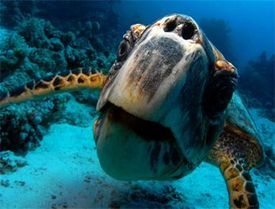HEPCA launches Turtle Research and Conservation Project
As part of its efforts to protect the Red Sea, HEPCA is launching a new research and conservation project focusing on sea turtles. The “Protecting Turtles of the Red Sea” project will complement HEPCA’s on-going efforts to conserve the coral reefs, sharks and marine mammals of the Egyptian Red Sea. This project will aim at improving our knowledge on the status of sea turtle population of the Red Sea, indentifying and quantifying major threats and finally proposing specific actions to reduce these threats. Red Sea turtles in trouble! Sea turtles appeared on Earth 110,000,000 years ago, and they have been living in our oceans ever since, surviving major natural disasters that provoked the extinctions of many species including the dinosaurs. However, in the past 50 years sea turtles populations declined sharply all over the world because of over-exploitation by humans. The 4 species that inhabit the Red Sea, the green, hawksbill, leatherback and olive-ridley turtles, are now threaten by irresponsible coastal development that destroys nesting beaches and feeding grounds such as seagrass beds and coral reefs; artificial lighting on main nesting beaches that disorients both nesting turtles and hatchlings; garbage and plastic bags in particular that could be ingested by mistake by turtles and will provoke a slow and painful death; pollution in the water that is often associated with diseases like the fibropapilloma tumor; irresponsible anchoring that destroys both seagrass beds and coral reefs; high speed boats and jet-skis that can seriously wound sea turtles and cause their death; incidental fishery in particular in industrial trawlers and purse seines. Why should you care? Sea turtles play an essential role in keeping the Red Sea healthy and full of life. Green turtles, aka “the sea cows”, maintain healthy seagrass beds which host spawing fish, their juveniles and a great number of other invertebrates like mollusks and crustaceans that are at the bottom of the entire food chain. Hawksbill turtles feed on corals and sponges, thus keeping them balanced. This balance has proven to be critical for a healthy coral reef. On their side, both leatherback and olive-ridley turtles feed on jellyfish, small size fish and other animals living on the water column. As jellyfish and small fish usually feed on fish eggs and larvaes, these two turtles reduce the pressure on many different fish species inhabiting the Red Sea. So sea turtle conservation is not just about turtles, but includes all the habitats they use and that we mostly enjoy as well, like the coral reefs. But a healthy sea turtle population depends on us and how we use the resources we share with these animals. What is HEPCA doing? HEPCA already launched some campaigns and projects that are also contributing to protect sea turtles: the mooring project, the “Stop the plastic bags” campaign but also the solid waste management program. For 2011, HEPCA wants to do more for turtles starting a conservation and research project focusing on these mysterious animals. For this reason, in the up-coming months we will launch the following activities: -TurtleWatch-Observe to conserve: a project directed to professional and recreational divers and snorkelers that will be asked to report on turtle sightings (as part of the HEPCA marine megafauna monitoring). -A turtle’s life in the Red Sea: a research project aimed at understanding sea turtle behavioral ecology in their feeding grounds. -Sea Turtles – A Manners and Etiquette guide: a collection of guidelines to promote responsible behavior when encountering a sea turtle; -Marine Megafauna Stranded and Salvage network: a project that will require the collaboration of all those living along the coast but also divers and snorkelers that will be asked to report any dead or injured marine animal stranded on the beach or floating at sea. -…and more activities to come soon! Do you want to know more about sea turtles and our turtle project? Please contact us



